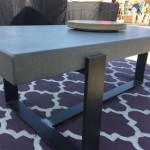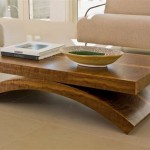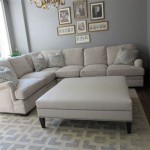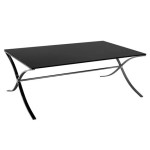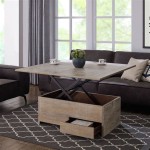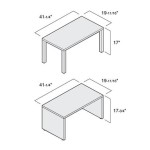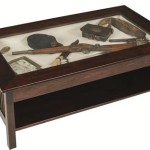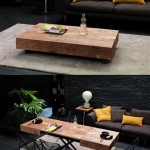Center Table Modern Design Ideas
The center table, often referred to as a coffee table, holds a significant position in modern living room design. It is more than just a surface to rest drinks or display decorative items; it serves as a focal point, setting the tone for the entire space. A well-chosen modern center table can enhance the aesthetics of a room, complement the existing furniture, and provide functional benefits. Selecting the right design requires careful consideration of factors such as size, shape, material, and style to ensure seamless integration with the overall interior design scheme. This article will explore various modern center table design ideas, providing insights into the diverse options available and their potential impact on your living space.
Modern design sensibilities emphasize clean lines, minimalist aesthetics, and functional utility. Center tables reflecting these principles often feature simple geometric shapes, muted color palettes, and innovative materials. The goal is to create a piece that is both visually appealing and practical, contributing to a comfortable and inviting living environment. The selection process must account for the specific needs and preferences of the homeowner, considering factors like the size of the room, the existing furniture style, and the intended use of the table.
Choosing the Right Shape and Size
The shape and size of the center table are critical factors in determining its suitability for a particular space. Common shapes include rectangular, square, round, and oval, each offering distinct visual and functional characteristics. Rectangular tables are often preferred for larger living rooms, providing ample surface area and complementing the linear arrangement of sofas and other furniture. Square tables work well in smaller spaces or when placed between a sofa and two chairs, creating a balanced and symmetrical look. Round and oval tables are excellent choices for softening the angularity of a room, promoting better traffic flow, and creating a more intimate seating arrangement.
The size of the center table should be proportionate to the size of the room and the surrounding furniture. A table that is too large can overwhelm the space, making it feel cramped and cluttered. Conversely, a table that is too small may appear insignificant and fail to provide adequate surface area. As a general rule, the center table should be approximately two-thirds the length of the sofa and positioned about 14 to 18 inches away from it. The height of the table should also be considered; it should ideally be the same height as the sofa cushions or slightly lower, allowing for easy access to items placed on the table.
Beyond the standard shapes, there are also more unconventional and organic forms emerging in modern center table design. These designs often incorporate asymmetrical shapes, multi-tiered surfaces, or sculptural elements, adding a unique and artistic touch to the living room. However, it is important to ensure that these unconventional shapes are still functionally practical and do not impede traffic flow or limit the usability of the table.
Exploring Material Options
The choice of material significantly impacts the visual appeal, durability, and overall style of the center table. Modern designs incorporate a wide range of materials, including wood, glass, metal, stone, and acrylic, each offering distinct characteristics and benefits. Wooden center tables are a classic choice, providing warmth, natural beauty, and versatility. Different types of wood, such as oak, walnut, maple, and teak, offer varying colors, grains, and textures, allowing for customization to suit different design preferences.
Glass-topped center tables create a light and airy feel, allowing the floor beneath to be visible and enhancing the sense of space. Tempered glass is a popular choice due to its strength and safety, while clear glass offers a minimalist aesthetic and tinted glass can add a touch of sophistication. Metal frames or legs, often made of stainless steel, iron, or brass, add a modern and industrial touch to the center table, providing structural support and visual contrast.
Stone center tables, such as those made of marble, granite, or slate, offer a luxurious and durable option, adding a sense of elegance and permanence to the living room. These materials are highly resistant to scratches and stains, making them ideal for high-traffic areas. Acrylic center tables are a contemporary choice, offering transparency, versatility, and the ability to be molded into various shapes and colors. These tables are lightweight, durable, and easy to clean, making them a practical option for modern homes.
The combination of different materials is also a common trend in modern center table design. For example, a wooden top can be paired with metal legs, or a glass top can be supported by a stone base. These combinations create visual interest and allow for a more personalized and unique design.
Integrating Style and Functionality
Modern center table designs prioritize both style and functionality, aiming to create pieces that are not only visually appealing but also practical and versatile. One key aspect of functionality is storage. Center tables with built-in storage compartments, drawers, or shelves provide valuable space for storing magazines, books, remote controls, and other items, helping to keep the living room organized and clutter-free.
Lift-top center tables are another functional option, allowing the table surface to be raised to a comfortable height for dining or working. These tables are particularly useful in smaller spaces where a separate dining table may not be feasible. Extendable center tables offer flexibility, allowing the table surface to be expanded when needed to accommodate more guests or activities. These tables are ideal for entertaining or when multiple people need to use the table simultaneously.
In terms of style, modern center table designs often incorporate minimalist aesthetics, clean lines, and geometric shapes. Neutral colors, such as white, gray, black, and beige, are commonly used to create a sense of calm and sophistication. However, pops of color can be added through accessories or by choosing a center table with a brightly colored base or top.
The style of the center table should complement the overall design of the living room. For example, a sleek and minimalist center table would be well-suited for a contemporary living room, while a rustic wooden center table would be a better fit for a farmhouse-style living room. It is important to consider the existing furniture, color palette, and decor when selecting a center table to ensure a cohesive and harmonious look.
Furthermore, the center table can be used to express personal style and creativity. Unique and artistic designs, such as sculptural pieces, reclaimed wood tables, or tables with unusual materials or finishes, can add a distinctive touch to the living room. However, it is important to strike a balance between personal expression and the overall aesthetic of the space, ensuring that the center table complements rather than clashes with the other elements in the room.
Ultimately, the ideal modern center table design should seamlessly blend style and functionality, enhancing the aesthetics of the living room while providing practical benefits for the homeowner. By carefully considering factors such as shape, size, material, and style, it is possible to select a center table that perfectly complements the existing decor and meets the specific needs and preferences of the user.
Modern center table designs are constantly evolving, reflecting trends in interior design and technological advancements. Smart center tables with built-in charging ports, Bluetooth speakers, or LED lighting are becoming increasingly popular, offering added convenience and functionality. Sustainable and eco-friendly center tables made from recycled materials or sustainably sourced wood are also gaining traction, reflecting a growing awareness of environmental issues.
The selection of a modern center table is a significant investment in the overall design and functionality of the living room. By carefully considering the various design options available and taking into account personal preferences and lifestyle, homeowners can create a living space that is both stylish and comfortable.

How To Style Your Modern Center Table

5 Decoration Tips On How To Style Modern Center Tables

50 Luxury Center Tables You Should Look Out For

Upgrade Your Living With These Modern Center Tables Home Decor Ideas

39 Easy Center Table Decor Ideas And Tips For Your Living Room Carla Bast Design

50 Modern Center Tables For A Luxury Living Room

94 Center Table Ideas Coffee Design

Discover How To Style Your Modern Center Table

Walnut Coffee Table Wooden Center Ball Livingroom Home Gift Balls İdeas Nordic Furniture

6 Center Tables Ideas Wood Tailors Club Riveting Craftsmanship
Related Posts

